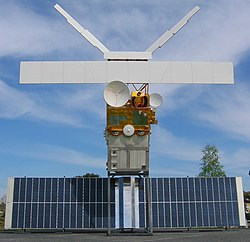Talk:Earth observation satellite
| This article is rated Start-class on Wikipedia's content assessment scale. It is of interest to the following WikiProjects: | |||||||||||||||||||||
| |||||||||||||||||||||
Article lacks data. Suggestions?
[edit]Why isnt there any other information on Earth Observation Satellites?
- I have no idea. It's still pretty much the same as the original version, from 29 March 2002. It has been edited dozens of times, but has hardly changed. Horatio (talk) 11:40, 19 February 2008 (UTC)
- What else would you like to see? Eve (talk) 15:40, 19 February 2008 (UTC)
- Something about the history and technology of Earth observation satellites, and more details about what sort of data is obtained, perhaps. Horatio (talk) 06:44, 20 February 2008 (UTC)
This Doesnt Read Right
[edit]"A weather satellite is a type of satellite that is primarily used to monitor the weather and climate of the Earth. Satellites can be either polar orbiting, seeing the same swath of the Earth every 12 hours, or geostationary, hovering over the same spot on Earth by orbiting over the equator while moving at the angular velocity of the Earth's rotation"
A satellite can have any orbit , they are not constrained to polar or geostationary. —Preceding unsigned comment added by 81.151.73.142 (talk) 09:26, 19 August 2009 (UTC)
Expansion-partial rewrite
[edit]The waste majority of Earth observation satellites are in orbits that are Sun-synchronous and "frozen". Some, but essentially only meterological satellites, are in geostationary orbits.
This should be clearly pointed out!
I plan to propose some re-write!
Stamcose (talk) 11:12, 25 June 2011 (UTC)
Additions and partly rewrite of the introduction
[edit]I would propose the following text as introduction. Comments and/or objections? Further improvements proposed?
++++++++++++++++++++++++++++++++

Earth observation satellites are satellites specifically designed to observe Earth from orbit, similar to reconnaissance satellites but intended for non-military uses such as environmental monitoring, meteorology, map making etc.
Most Earth observation satellites carry instruments that should be operated at a relatively low altitude. But altitudes below say 500-600 kilometers are in general avoided, though, because of the significant air-drag at such low altitudes making frequent orbit raising manoeuvres necessary. The Earth observation satellites ERS-1, ERS-2 and Envisat of European Space Agency as well as the MetOp spacecraft of the European Organisation for the Exploitation of Meteorological Satellites are all operated at altitudes of about 800 km. The Proba spacecraft of European Space Agency is observing the Earth from an altitude of about 600 km.
To get a (close to) global coverage with such a relatively low orbit it has to be polar or at least close to polar. As such a rather low orbit will have an orbital period of roughly 100 minutes the Earth will rotate around its polar axis with about 25 deg between sucessive orbits with the result that the ground track is shifted towards west with these 25 deg in longitude.
For spacecraft carrying instruments for which an altitude of 36000 km is suitable the Geostationary orbit could be the prefered choise. From such an orbit one gets uninterupted coverage of more then 1/3 of the Earth. With 3 geostationary spacecraft positioned over the equator at longitudes separated with 120 deg the whole Earth is covered except the extreme polar regions. This type of orbit is mainly used for meterological satellites.
Stamcose (talk) 12:29, 26 June 2011 (UTC)
External links modified
[edit]Hello fellow Wikipedians,
I have just modified 2 external links on Earth observation satellite. Please take a moment to review my edit. If you have any questions, or need the bot to ignore the links, or the page altogether, please visit this simple FaQ for additional information. I made the following changes:
- Added archive https://web.archive.org/web/20080819121047/http://earthobservatory.nasa.gov/Drought/ to http://earthobservatory.nasa.gov/Drought/
- Added archive https://web.archive.org/web/20160406191132/http://www.campevans.org/_CE/html/tiros1-2.html to http://www.campevans.org/_CE/html/tiros1-2.html
When you have finished reviewing my changes, you may follow the instructions on the template below to fix any issues with the URLs.
This message was posted before February 2018. After February 2018, "External links modified" talk page sections are no longer generated or monitored by InternetArchiveBot. No special action is required regarding these talk page notices, other than regular verification using the archive tool instructions below. Editors have permission to delete these "External links modified" talk page sections if they want to de-clutter talk pages, but see the RfC before doing mass systematic removals. This message is updated dynamically through the template {{source check}} (last update: 5 June 2024).
- If you have discovered URLs which were erroneously considered dead by the bot, you can report them with this tool.
- If you found an error with any archives or the URLs themselves, you can fix them with this tool.
Cheers.—InternetArchiveBot (Report bug) 01:26, 16 September 2017 (UTC)
اجمل من الاول شكرا
[edit]س سحب
41.236.44.33 (talk) 11:21, 12 October 2024 (UTC)
- Sad229.com 41.236.44.33 (talk) 11:22, 12 October 2024 (UTC)


